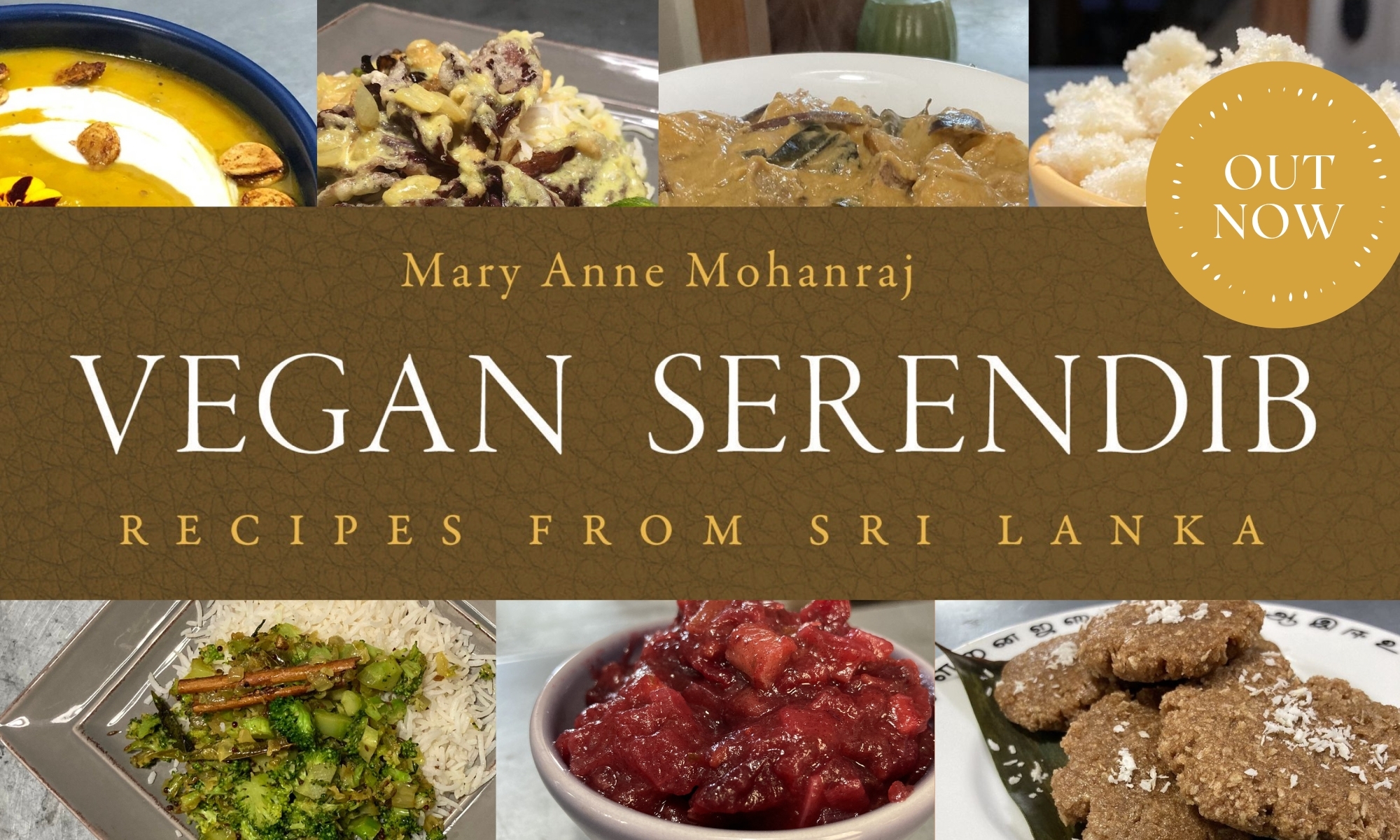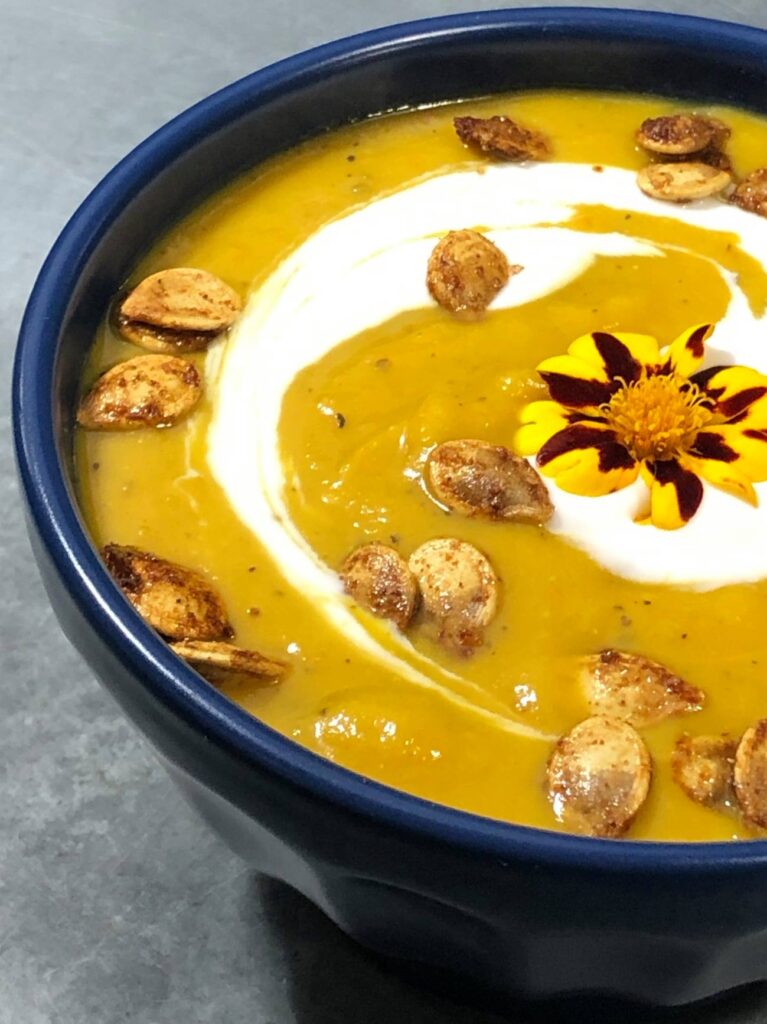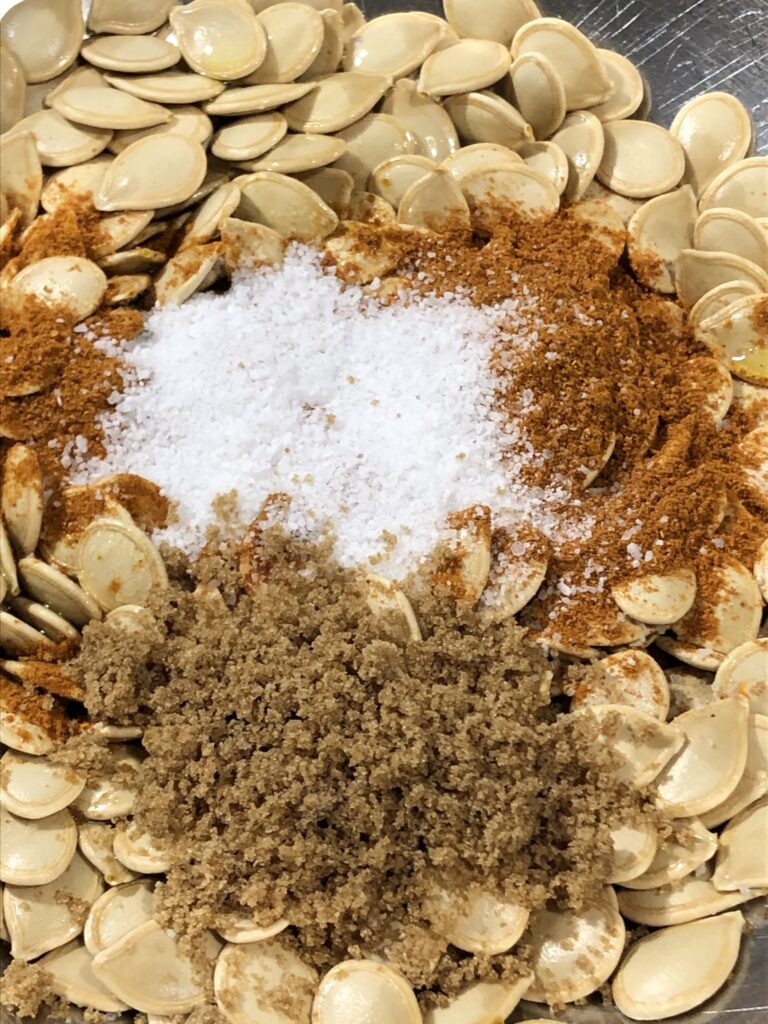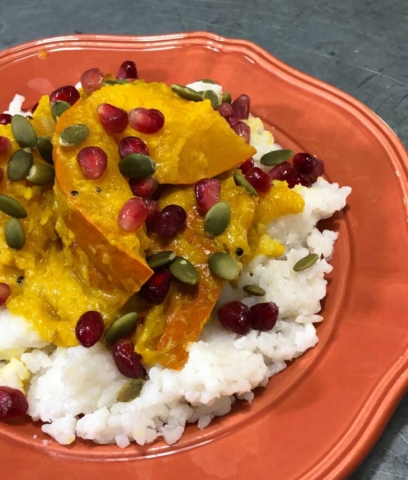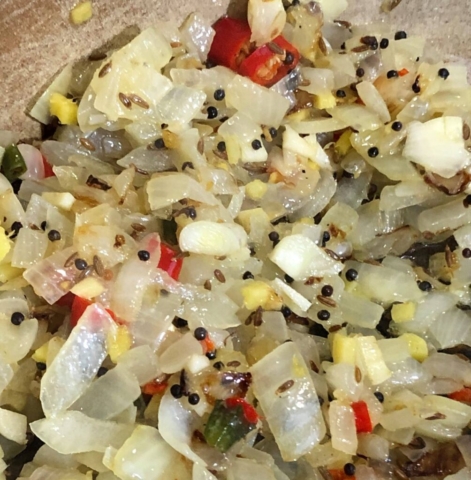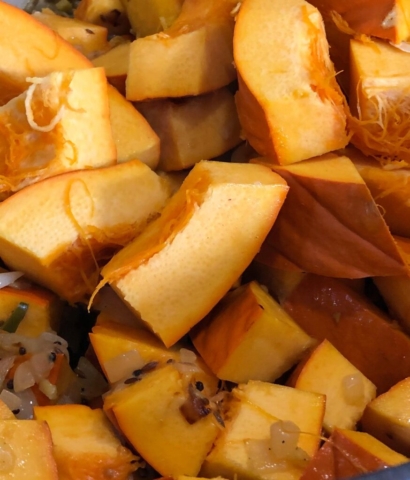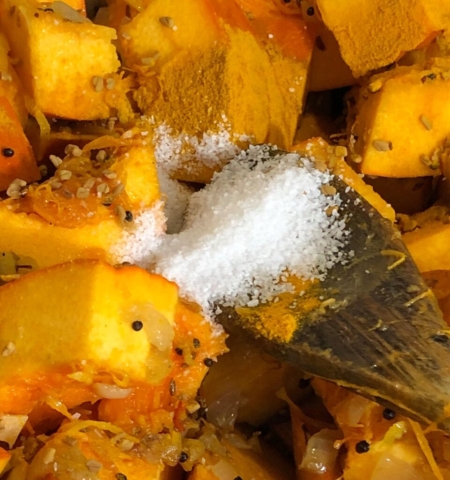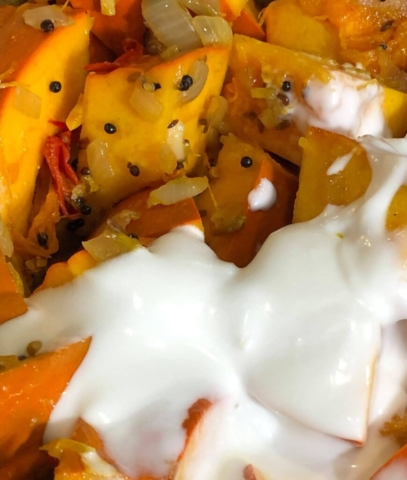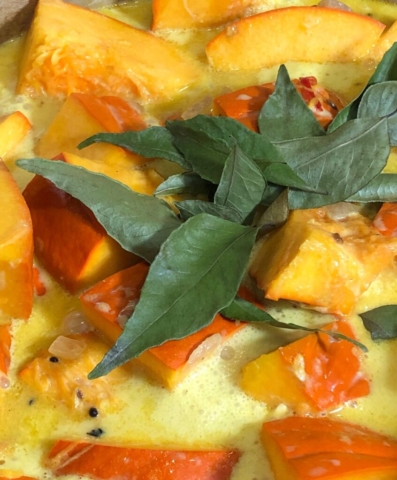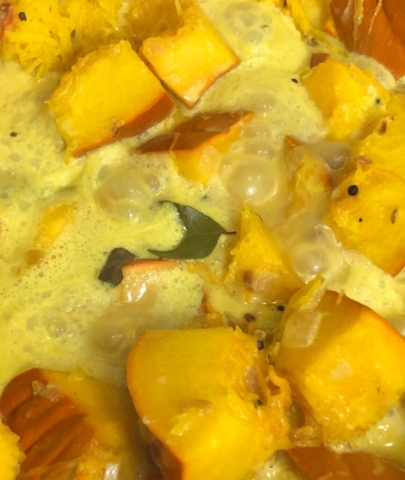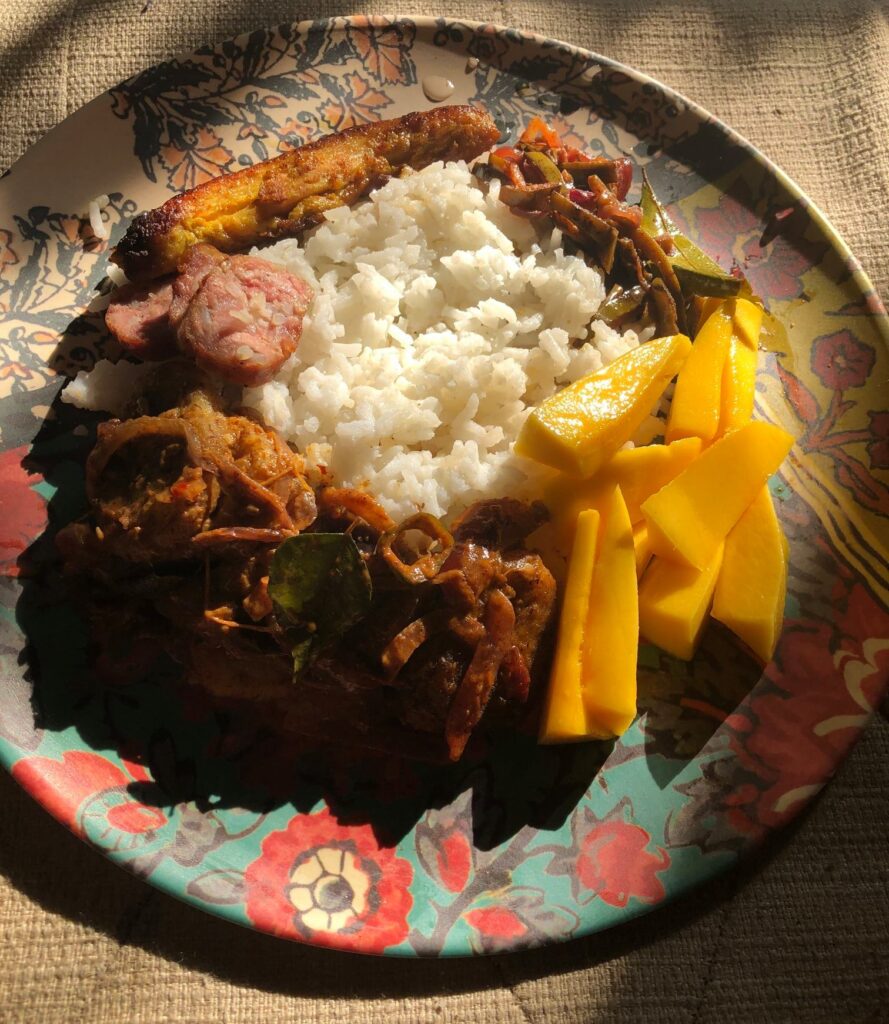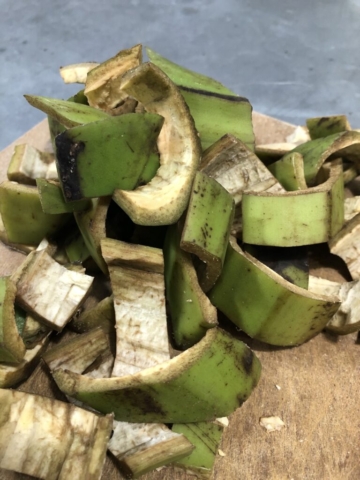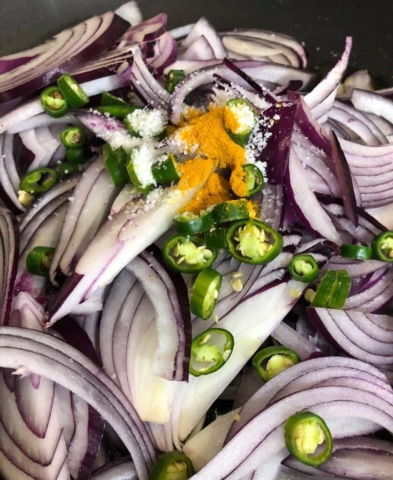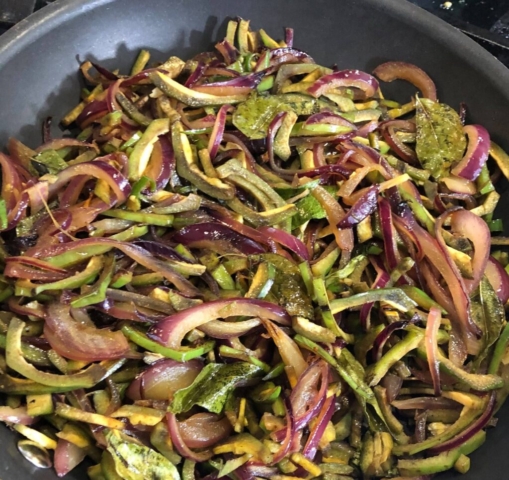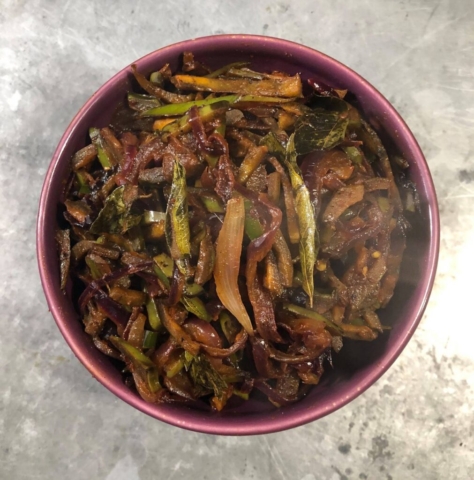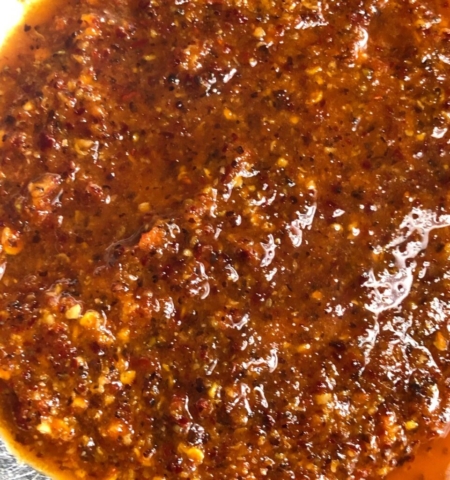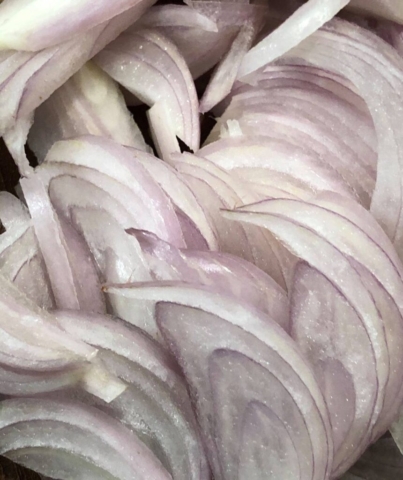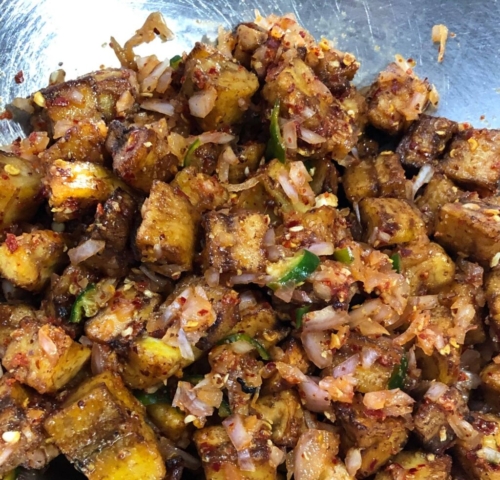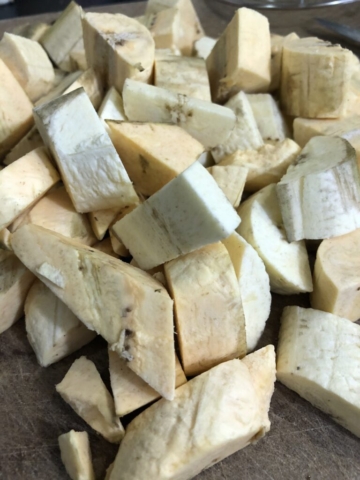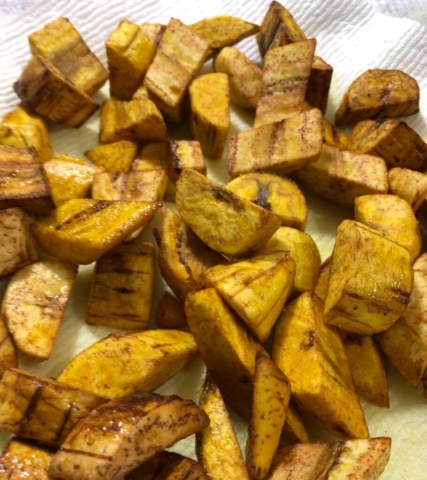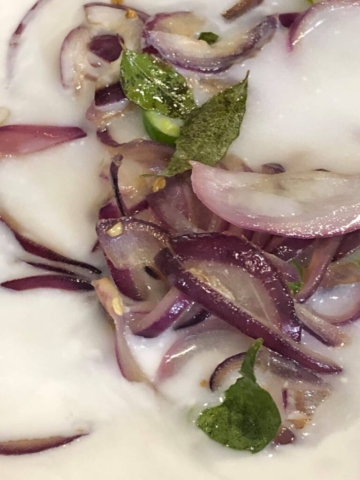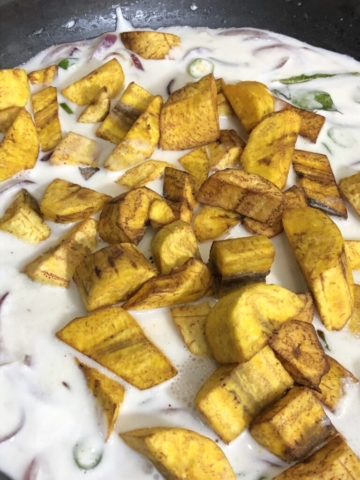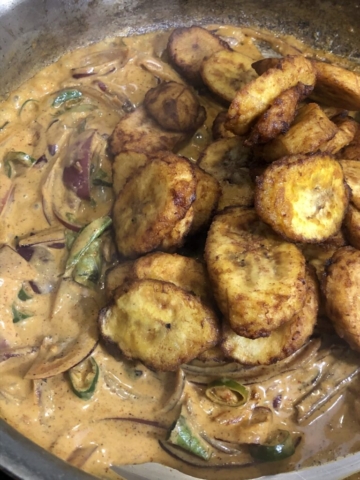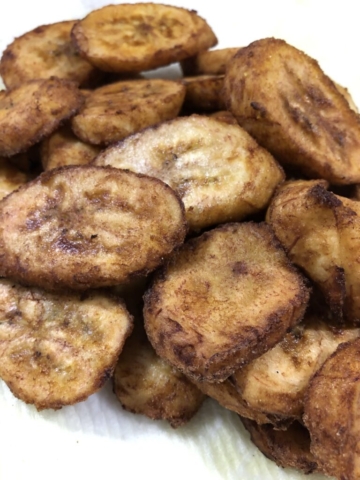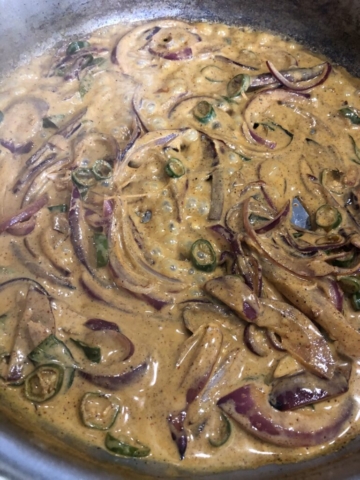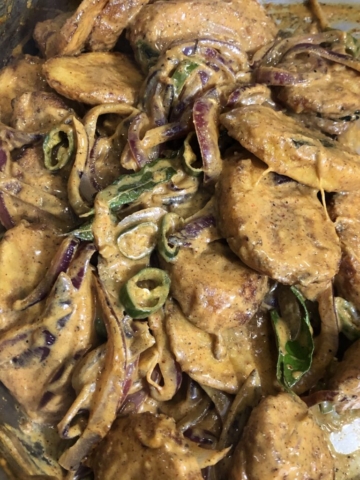I’m giving myself all the points for actually cooking a reasonable dinner tonight (chicken curry and uppuma and Roshani’s coconut sambol — going old-school), AND putting in 30 minutes on the treadmill. Cooking and eating and treadmilling were pretty good distractions too.
Essays on Food
Well, that was unexpected. I needed a writing sample for this fellowship application, and I pondered for a bit and realized what I really wanted to submit was a food essay, since I’m hoping to write and place a bunch of food essays, then turn them into some kind of memoir-thing.
But I’ve actually been planning this for many many months, and even took a food writing class online with Pooja Makhijani, and while I had written a whole bunch of bits and pieces, none of them had really cohered into an essay yet.
BUT I had a little time tonight (thank you, grants folks, for an 11:59 p.m. deadline, much appreciated), so around 6:30, I told Kevin I was going to go hide in the shed and try to write something. Five hours later, having taken work heavily from various earlier projects that never quite cohered, I appear to have written a 4100 word essay that I’m moderately pleased with.
This is actually a tremendous relief, because I kept saying and saying that I was going to write food essays, but not actually doing it. Maybe I just needed a deadline to get me over the hump.
I could use a few beta readers before I try submitting it anywhere. Also, I have to research who publishes 4000 word food essays. If you’re interested in taking a look and sending me your thoughts, drop your e-mail in comments. ![]()
…
“The day I arrived in this country, the taxi driver deposited me safely at Galle Face Hotel, a colonial dream. Two hundred years old, and for a long time the province of white masters who enjoyed the service of their brown-skinned, white-jacketed servants. The lobby wasn’t air-conditioned, unlike the more modern five-star hotels down the street; it sat open to the salt breezes and the occasional drift of sunshine. A man in crisp white uniform brought me a glass of fresh juice, which might have been the best thing I’d tasted in my life. Mango, distilled to its pure, explosive essence; what I’d been drinking as mango in America was insolent imitation. On this island, reality shifted and took on new forms. My old certainties felt fragile, ready to shatter at a thought, or an unkind word.”
Curried Pumpkin Soup
1 batch pumpkin curry (see recipe here: http://serendibkitchen.com/2020/11/01/pumpkin-curry/)
1/2 – 1 t. additional salt, to taste
Optional garnishes: coconut milk, marigold petals, Sri Lankan-style roasted pumpkin seeds (recipe here: http://serendibkitchen.com/2020/11/01/roasted-pumpkin-seeds-sri-lankan-style/)
1. Make pumpkin curry in a large pot. (I recommend peeling the pumpkin if you plan to use it for soup.)
2. Add stock and cinnamon stick, bring to a boil, turn down and simmer for 20 minutes or so, stirring occasionally.
3. Remove cinnamon stick and purée until smooth. Optional, but makes it pretty and gives the soup a velvety texture — an immersion blender makes this job much easier than trying to transfer hot soup into a blender safely.
4. Stir in lime juice, taste, add salt if needed.
Roasted Pumpkin Seeds, Sri Lankan-Style
The white seeds you get from a carving pumpkin are actually pumpkin seed husks — if you really wanted to, you could do a lot of work trying to get to the green seeds (known as pepitas) inside. Pepitas are delicious, but are actually usually harvested from pumpkins that don’t produce these white husks. But don’t throw these away — big white pumpkin ‘seeds’ are great roasted too, adding in some extra fiber and a nice crunch.
You could just toss them with a little oil and salt, but why not kick it up a notch? Try them Sri Lankan-style — these are a terrific topping for a curried pumpkin soup. Salty + sweet + savory + spicy. Perfect.
1 t. Sri Lankan roasted curry powder (with or without 1/2 t. cayenne, your choice)
1. Preheat oven to 300 F.
2. Toss seeds with oil and spices.
3. Spread in a flat layer on a sheet of foil and roast for about 40 minutes, until dry and crispy. (Keep an eye on them for the last 5-10 minutes of roasting, to make sure they don’t burn.)
Enjoy as a snack on their own, or topping your favorite autumn dishes.
Pumpkin Curry
(30-45 minutes, feeds 8)
The orange pumpkins that are so familiar in America don’t actually grow in Sri Lanka, but the same approach used for Sri Lankan ash pumpkins (also known as wintermelon) works well for orange pumpkins too, offering a mild, comforting curry rich in autumn flavor,
Typically in Sri Lanka, you’d leave the pumpkin skin on for cooking, and it can then either be eaten, or removed easily with your fingers. But if you’re eating with a fork instead of your clean hand, that may be a little tricky to manage — feel free to peel your pumpkin if you like.
One key to this curry is to cut the pumpkin into different sized chunks, so that the smaller pumpkin pieces dissolve into a curry sauce, and the larger ones stay in soft pieces.
I used a medium-sized five pound pumpkin for this dish, but you can certainly reduce the quantity — just reduce the onions and other spices roughly proportionately. But one nice aspect of making a big pumpkin curry, is that after you’ve eaten it for a day or two, any leftovers can be put on the stove, some broth added, and cooked down into a lovely soup. The soup also freezes well.
pomegranate and pumpkin seeds for garnish, optional
1. Heat oil in a large pot and sauté onions, ginger, garlic, chilies, and spices over medium heat, stirring, until onions are golden-translucent.
2. Add pumpkin, curry leaves, coconut milk and water; bring to a boil, then turn down to a simmer.
Luxurious
Chilly outside, but a little tropical sunshine on my plate. I’m cooking mostly vegan food these days, developing recipes for the cookbook, but we’re also still trying to support our local restaurants — we got Thai takeout last night, so there’s a little Thai sausage and chicken satay on the plate, then going clockwise, tempered plantain peel, fresh mango, and spicy plantain curry. Luxurious.
Tempered Green Plantain Peel
(20 minutes, serves 8 as accompaniment)
I was raised a frugal New Englander, and I truly hate wasting food. So you can imagine how excited I was when I learned that plantain (and banana) peel is actually edible! I like making this with green plantain peel, for the color contrast with the red onion, but you can also use ripe plantain, or green or ripe banana peel.
1 T lime juice
1. Heat oil in a frying pan; add sliced peel, red onion, green chili, curry leaves, cayenne, turmeric, and salt. Sauté on medium, stirring occasionally, until peel is cooked through and a little crispy, about 10-15 minutes. If it starts sticking, add a little water and scrape it up.
Plantain Sambol
(20 minutes, serves 4 as accompaniment)
Plantains are staple foods throughout Sri Lanka and the region, the main fare of millions of people for centuries. They’re rich sources of complex carbohydrates, vitamins, and minerals, and are easily digestible. This traditional Jaffna-style plantain sambol offers a luscious, spicy-tangy bite, and is a great way to perk up a plate of rice and curry.
1/2 t. salt, optional
1. Peel plantains and dice, then toss with 1/2 t. salt and turmeric.
2. Heat oil and fry diced plantain until golden; remove to a plate lined with kitchen towels and set aside.
3. Combine dry chilies, vinegar, mustard seeds and sugar to a smooth paste (in a blender or using a mortar-and-pestle).
Green Plantain Curry
(45 minutes, serves 4)
Green plantains are starchy and not sweet, more like a vegetable than a fruit — if you’ve had tostones, those are made from green plantains. Expect these fried green plantain bites to be much like potatoes in texture, but with a flavor all their own; I like them simmered in a mild coconut milk curry, with just a hint of green chili.
NOTE: You can save plantain peels to cook them too.
1-2 T lime juice
1. Cut plantains in half lengthwise and remove peel with a paring knife. Slice plantains on the diagonal in roughly 1/4″ slices, then toss with 1/2 t. salt and turmeric.
2. Heat oil and fry plantain slices until golden; remove to a plate lined with kitchen towels and set aside.
3. In a separate large sauté pan, heat 1-2 T of the oil and add onion, chilies, curry leaves, fenugreek seeds, and salt. Sauté about 10 minutes on medium-high, stirring occasionally, until onions are softened and translucent.
Spicy Plantain Curry
(30 minutes, serves 4)
Sri Lanka grows a host of plantains and bananas; this type of curry is typically made with a variety known as ash plantain. That’s not easy to find in America, but luckily, plantains generally have become much more available, and they work beautifully in this dish. You can even use very green bananas if you like.
After the first frying stage, the plantains should be just a little bit sweet, and can be eaten straight up if you like as a snack, or added to a plate of rice and curries. But add them to this curry sauce, and the spicy, tangy sauce meets the sweetness of the fried plantain, for what I can only call a taste explosion. In a good way!
NOTE: You can save plantain or banana peels to cook them too.
1-2 T lime juice
1. Slice plantains on the diagonal in roughly 1/4″ slices, then toss with 1/2 t. salt and turmeric.
2. Heat oil and fry plantain slices until golden; remove to a plate lined with kitchen towels and set aside.
3. In a separate large sauté pan, heat 1-2 T of the oil and add onion, chilies, curry leaves, and fenugreek seeds. Sauté about 10 minutes on medium-high, stirring occasionally, until onions are softened and translucent.
4. Add cayenne, curry powder, and 1/2 t. salt, and stir a few minutes more, then stir in coconut milk.
